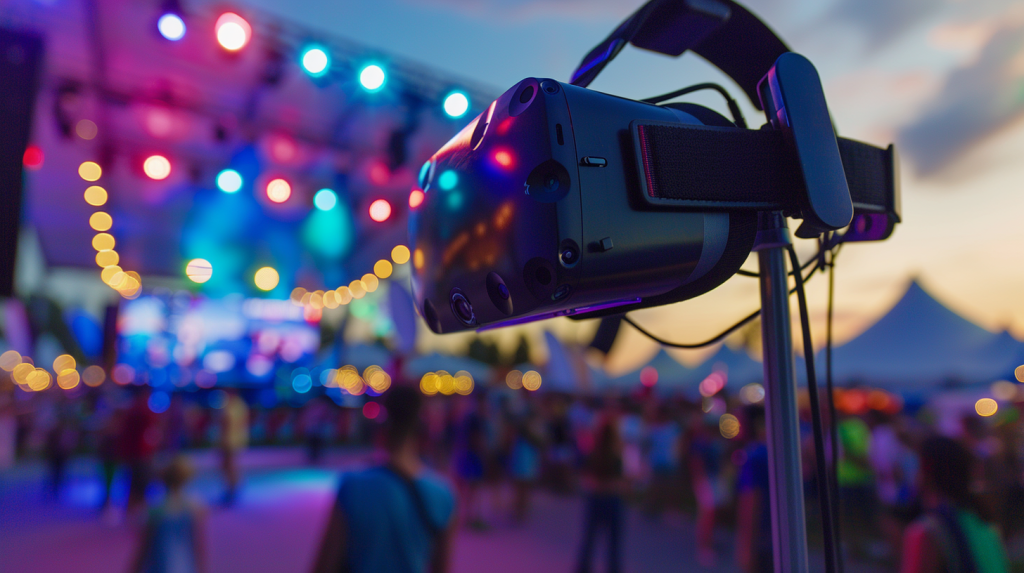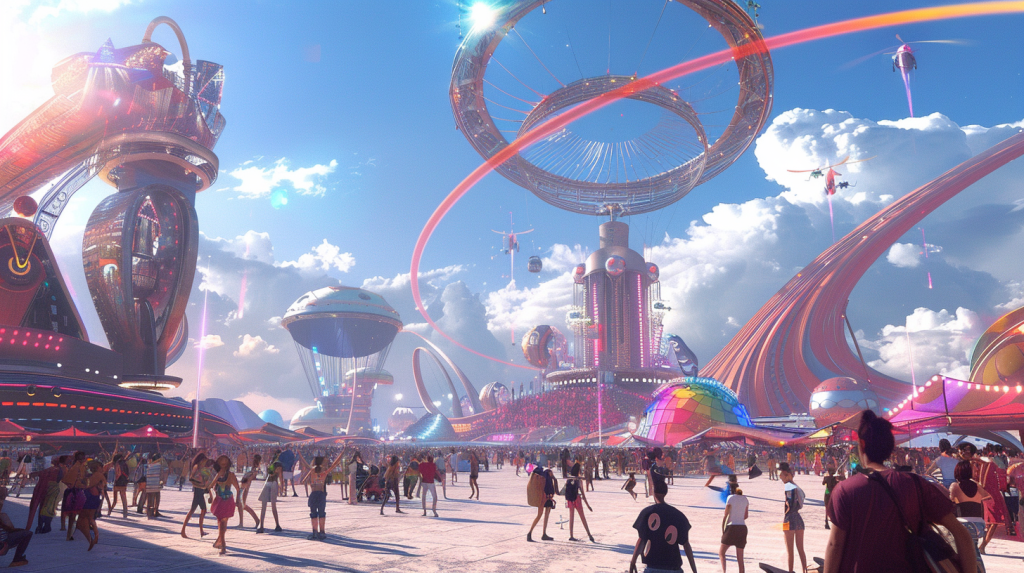2050, it’s a bit far away. Before I know it, I’ll be 47 years old reading back on this, judging my predictions and if they were correct, had some truth to them, or were completely off base. So, Kai in 2050 if you’re reading this, hope I did you proud and you’re doing alright mate. Okay let’s get back on track for the last time this semester, akin to my 2030 and 2040 blog posts, we’ll be using Bell’s (1998) future thinking model of possible, probable and preferable futures to imagine what music festivals might look like in 2050. Because 2050 is so far into the future that it’s difficult to gain a substantial insight, I’ve reflected on the past and present, to fine tune my predictions.
Possible

The use of virtual reality (VR) will have matured amongst consumer audiences and be a more accessible form of entertainment by 2050. As VR technologies become more accessible and utilised, is when consumers will mature with the idea of use and indulgence. The concept of VR has been in circulation since the mid-to-early 20th century, the term ‘virtual reality’ wasn’t coined until 1982 (Moore 2020) and although VR technologies are getting cheaper, with the average cost being $676 AUD in 2023 (Lee et al. 2023), most headsets still require powerful external computing systems, which still leaves a major entry barrier for majority of consumers. Now when taking historical patterns into account, we can use it to visualise the possibility of a widespread uptake of VR capabilities. What does this mean for music festivals? I don’t think it will eradicate the physicality of music festivals, but provide more opportunities for festivals to sell their experience. Festivals could have a live VR feed for viewers to experience, or virtual festival maps to explore. This has been attempted before with Splendour XR, attendees could watch pre-recorded performances in a Splendour venue metaverse, not to be seen again. The virtual event is a technological novum, reflecting on its present conditions being created in lieu of COVID-19 event cancellations, whilst being the first of its kind. Although it was criticised for lacking in realism, it demonstrates what is possible, and that full immersion can be achieved. With the pace of technological innovation, it’s possible for this to become a *virtual* reality by 2050 and be a common alternative to physical music festivals.
Probable

By the time 2050 rolls around, it’ll be safe to stay that most people will be comfortable with the presence and use of AI, with a majority already feeling so (Gillespie et al. 2023). Again, as history shows, the more a technology becomes present and accessible, the more we adapt. The way I think AI will most likely be used, is through a pragmatist lens, that AI will be able to expand human capacity (Makridakis 2017). Something I failed to mention in my 2040 post, is the use of AI in climate analysis, and how this can aid the festival industry. The effects of climate change are bound to worsen, the pace of which that occurs at, remains dependent on social and political action. AI has been used in forecasting climate contexts for quite some time (Cowls et al. 2021), and the more data it gathers over the course of time, the more informed predictions can be made. This feeds into operations research and planning for future iterations of live events. Explainable AI in operations research sees a bias of performative analytics (valid decisions) when evaluating results and decisions, finding an under-representation of attributable (causal) and responsible (legal, ethical) analytics (De Bock et al. 2023), this may cause an ethical barrier to dependence on AI with human intervention needed to influence decision making. When considering the use of AI in music festival logistics, the number of resources needed for a successful event is astronomical, with current average costs for an Australian music festival sitting at $3.9 million, and only 8% of festivals breaking even (Creative Australia 2024). Although operational research AI models may be able to drastically decrease logistics and setup costs, the question remains if it will be capable to do that whilst minimising risk to patrons’ safety.
Preferable

Looking at preferable future in Australian music festivals, I hope to see the theme and maintenance of outdoor venues be carried through the years. Although indoor venues are the safer option being more predictable and controllable, outdoor venues provide flexibility in site structure and can host beyond internal capacity limits. The decision made to hold an event outdoors presents a socially open and optimistic view upon the festival’s success. Although the planning is carefully considered to host it at a time of year that isn’t prone to poor weather, however the unpredictable elements and effects of climate change puts the success in question until the event has concluded. Nonetheless, the location of the festival can be a relevant factor when deciding attendance (Gill et al. 2015). Through the evolution of AI and operations research aiding in climate analysis and logistics, I believe that it’ll be possible for these kinds of events to go forth in future. Another aspect I would like to see and is likely the most plausible is the evolution of sound and what new genre fusions can be created. With music being more accessible than ever from the hands of streaming, allows for emerging musicians to gain even more inspiration than ever. With AI in the mix, provides the possibility of artists collaborating with AI more and more. Although its ultimately up to the peanut gallery of consumers to decide who deserves their listening in an attention economy, creative freedom is reaching a point that knows no bounds.
To conclude, although 2050 is far out of reach, we can still gain a decent gauge of what might be circulating in the music festival industry. Bell’s model allows to consider a wide scope of current and past patterns to evaluate the future, and I’ve enjoyed using it, considering paths I otherwise wouldn’t have thought of. Whatever the future may hold for music festivals, I just hope to see more Australian artists celebrated by Australians, because at the core of it all, that’s what keeps the cogs turning in the Australian music festival industry.
Cover image created my Midjourney using prompt: what will a music festival look like in 2050? retro-futurism style –ar 16:9
Video logo created by Ideogram using prompt: create me a 1980s retro logo that says “future cultures with Kai”
References:
Computer History Museum, Timeline of Computer History, Computer History Museum, viewed 21st May 2024, https://www.computerhistory.org/timeline/computers/.
Cowls, J., Tsamados, A., Taddeo, M. & Floridi, L. 2023, ‘The AI gambit: leveraging artificial intelligence to combat climate change—opportunities, challenges, and recommendations’, AI & society, vol. 38, no. 1, pp. 283–307.
Creative Australia & Australian Government, Soundcheck: Insights into Australia’s music festival sector, Creative Australia, Sydney NSW, viewed on 21st May 2024, https://creative.gov.au/advocacy-and-research/soundcheck-insights-into-australias-music-festival-sector/.
De Bock, K.W., Coussement, K., De Caigny, A., Słowiński, R., Baesens, B., Boute, R.N., Choi, T.M., Delen, D., Kraus, M., Lessmann, S., Maldonado, S., Martens, D., Óskarsdóttir, M., Vairetti, C., Verbeke, W. & Weber, R. 2024, ‘Explainable AI for Operational Research: A defining framework, methods, applications, and a research agenda’, European Journal of Operational Research, vol. 317, no. 2, pp. 249-272, https://doi.org/10.1016/j.ejor.2023.09.026.
Dwyer, M. 2021, ‘I went to the world’s first virtual music concert and all I got was an unsexy robot suit and a headache’, The Sydney Morning Herald, 25th July, viewed 21st May 2024, https://www.smh.com.au/culture/music/i-went-to-the-world-s-first-virtual-music-concert-and-all-i-got-was-an-unsexy-robot-suit-and-a-headache-20210723-p58ch4.html.
Gill, K, Ollenburg, C & Nash, R 2015, ‘What Motivates Young People to Attend Music Festivals and What Role Do Peer Pressure and Alcohol Consumption Play in Attendance?’, JOHAR, vol. 10, no. 1.
Gillespie, N, Lockey, S, Curtis, C, Pool, J, & Akbari, A 2023, Trust in Artificial Intelligence: A Global Study, The University of Queensland and KPMG Australia.
Lee, P., Arkenberg, C., Stanton, B., Cook, A. 2023, Will VR go from niche to mainstream? It all depends on compelling VR content, Deloitte, viewed 21st May 2024, https://www2.deloitte.com/content/dam/Deloitte/pt/Documents/technology-media-telecommunications/TMTPredictions/tmt-predictions-2023/DI_TMTP23-VR-hardware.pdf.
Makridakis, Spyros (2017) “The Forthcoming AI Revolution: Its impact on society and firms”, Futures, (90), 46-60.
Moore, C. 2020, ‘BCM325 Future Cultures: Cyberculture Series (4 of 4) Cyberspace’ lecture, BCM 325, University of Wollongong, viewed 21st May 2024.
Paavola, A. 2022, Smartphone history: a complete timeline, Textline, viewed 21st May 2024, https://www.textline.com/blog/smartphone-history.
Bell, W, 1998, ‘Making people responsible: The possible, the probable, and the preferable’, American Behavioral Scientist, 42(3), pp.323-339.


Leave a comment